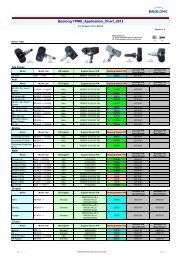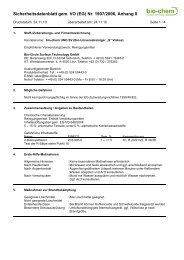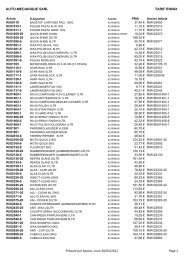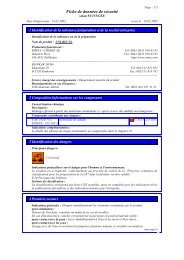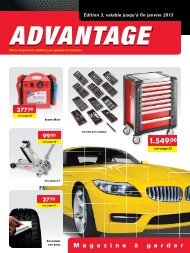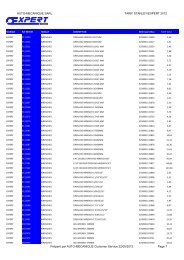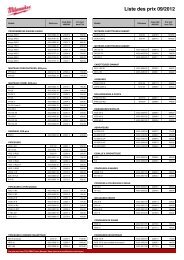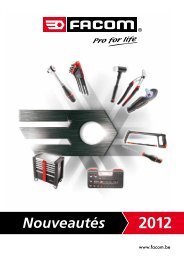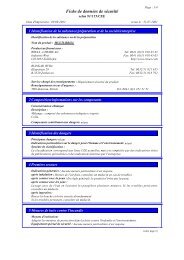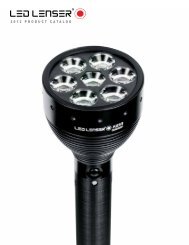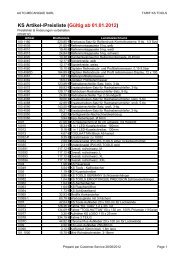REPAIR & SUPPLIES - Auto-Mecanique
REPAIR & SUPPLIES - Auto-Mecanique
REPAIR & SUPPLIES - Auto-Mecanique
You also want an ePaper? Increase the reach of your titles
YUMPU automatically turns print PDFs into web optimized ePapers that Google loves.
Press (Loading) – A machine designed to open and<br />
close a matrix, load and eject retreaded tires.<br />
Press Plate – Ring shaped plates in molds which<br />
may be adjusted to alter the cross section of tires.<br />
Pyrometer – An instrument to measure temperatures<br />
– usually by the generation of electric current<br />
by a thermocouple when acted on by direct heat.<br />
Commonly used to measure surface mold temperatures<br />
or (if a penetrating needle is used) tread rubber<br />
temperatures.<br />
Rasp – A tool with raised points forming the cutting<br />
prominences, used for roughening rubber surfaces.<br />
Radial Cracking – Cracking, usually in or near the<br />
rib area, resulting from under-inflation (or ozone<br />
exposure).<br />
Reducing Valve – Pressure regulating device used<br />
for controlling steam or air pressure at desired level.<br />
Regrooving (Recutting) – The cutting of a tread<br />
design into tread rubber where a design does not<br />
already exist or the cutting into an existing tread<br />
design to a depth greater than that provided by the<br />
new tire manufacturer or retreader.<br />
Reinforcement – Any material, usually rubber and<br />
fabric, vulcanized to the tire to add strength to the<br />
cord body at an injury.<br />
Reinforcement Repair – Repairs made to the<br />
casing when an injury has extended through more<br />
than 25% but less than 75% of the tire body requiring<br />
both hole-filling material and reinforcing patches.<br />
Relugging – A method of retreading big type design<br />
tires using hand build-up and kettle cure.<br />
Repair Gum – Material used for filling voids, or<br />
covering reinforcing material in a tire repair.<br />
Repaired Tire – Any tire with punctures, cuts or<br />
other types of injuries that have been reconditioned<br />
as required to provide additional safe service life.<br />
Repair Patch – The reinforcing material used to<br />
seal and/or reinforce the injury in a tire.<br />
Repair Plug – The material that fills the cavity<br />
of an injury in a tire.<br />
Retread Tire – A casing to which tread rubber has<br />
been affixed to extend the usable life of the tire.<br />
Reversion – Excessive heating of a cured rubber<br />
compound leading to deterioration of its physical<br />
properties.<br />
Rim – A metal support for a tire or a tire and tube<br />
assembly upon which the tire beads are seated.<br />
Rim Diameter – The diameter (conventionalized)<br />
of the rim corresponding to the tire bead heel.<br />
Rim Flange – That part of the rim that supports<br />
the bead heel and resists lateral internal pressure.<br />
Rust – Advanced stage of corrosion (See Corrosion).<br />
Scorching of Rubber – Excessive heat of processing<br />
equipment which detrimentally changes the surface<br />
of the rubber.<br />
Section Repair – Repairs, other than nail-hole type,<br />
made to the casing when an injury has extended<br />
through 75% or more of the actual plies, or completely<br />
through the casing in the tread or sidewall areas.<br />
Sectional Bag (Air-Steam) – A rubberized fabric<br />
bag made in 1/4, 1/5, or 1/6 circle with valves at both<br />
ends. When inflated inside a tire in a sectional mold,<br />
it applies pressure in the vicinity of the injury.<br />
Self Vulcanization – (See Chemical Cure).<br />
Separation – A loosened area within the tire.<br />
Set-up – Premature vulcanization of a rubber<br />
compound during processing or storage.<br />
Shaping – Buffing the casing to shape it to properly<br />
fit the size and contour of the matrix cavity.<br />
Shelf-Life – Refers to the accepted length of time<br />
that a perishable product may remain in stock before<br />
serious deterioration takes place.<br />
Shoulder Radius – Small radius, (generally) that joins<br />
the primary tread radius to the shoulder contour.<br />
Sidewall – That portion of a tire between the tread<br />
and bead.<br />
Sipe – Any of the small often hooked shaped or<br />
bracket shaped grooves in the tread of an automobile<br />
tire for providing extra traction and preventing skids.<br />
Size Factor – The size factor of a tire is the sum of<br />
its section width on its measuring rim and its outer<br />
diameter.<br />
Sizing – Measuring the tire casing to determine<br />
proper matrix fit. Usually a combination of bead to<br />
bead or cross section and tire circumference is used.<br />
Skid Depth (Tread Depth) – The distance measured<br />
near the centerline of the tire, from the base of the<br />
tread design to the top of the tread.<br />
Skiving – The removal of damaged material prior<br />
to making a repair.<br />
Slab Stock – Tread compound cut from a rubber mill<br />
in wide, thick strips.<br />
Spacer Ring – A ring inserted between two halves of<br />
a matrix which enables the matrix to handle tires of<br />
the same diameter, but with greater tread widths and<br />
larger cross sections.<br />
Special Mileage Tire – A tire manufactured with<br />
an extra layer of rubber between the cord body<br />
and the original tread design, which extra layer is<br />
designed for the purpose of recutting and regrooving,<br />
and which is specifically labeled as a special mileage<br />
commercial tire.<br />
120



